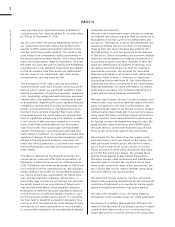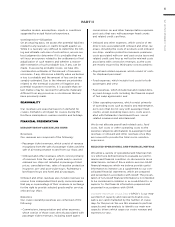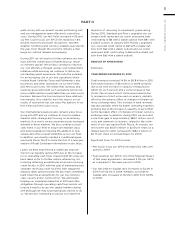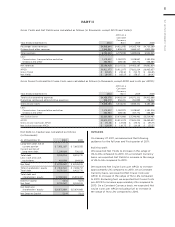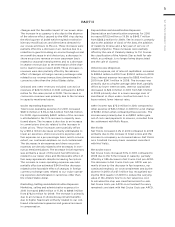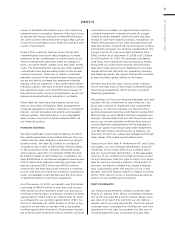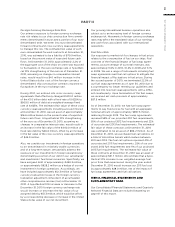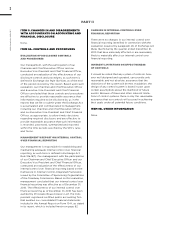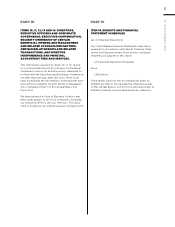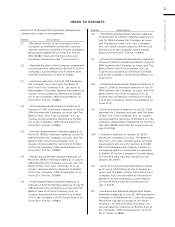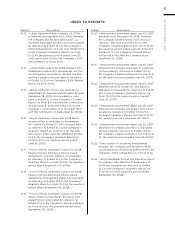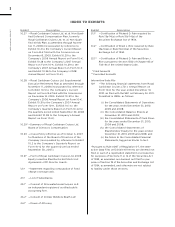Royal Caribbean Cruise Lines 2010 Annual Report Download - page 53
Download and view the complete annual report
Please find page 53 of the 2010 Royal Caribbean Cruise Lines annual report below. You can navigate through the pages in the report by either clicking on the pages listed below, or by using the keyword search tool below to find specific information within the annual report.
2010 ANNUAL REPORT 50
PART II
approx imately 5,850 berths. The aggregate cost of the
two ships including amounts due to the shipyard and
other ship related costs is approximately $1.8 billion,
of which we have deposited $199.3 million as of
December 31, 2010. Approximately 2.2% of the aggre-
gate cost of the ships on order was exposed to fluctua-
tions in the euro exchange rate at December 31, 2010.
(See Note 13. Fair Value Measurements and Derivative
Instruments and Note 14. Commitments and Contin-
gencies to our consolidated financial statements under
Item 8. Financial Statements and Supplemen tary Data).
As of December 31, 2010, we anticipated overall capi-
tal expenditures, including the two ships on order, will
be approximately $1.0 billion for 2011, $1.0 billion for
2012 and $350.0 million for 2013.
In February 2011, we reached a conditional agreement
with Meyer Werft to build the first of a new generation
of Royal Caribbean International cruise ships. The ship
will have a capacity of approximately 4,100 berths
based on double occupancy and is expected to enter
service in the fourth quarter of 2014. The agreement
will become definitive upon satisfaction of several
conditions, including financing. We also have an option
to construct a second ship of the same class which
will expire on February 28, 2012, subject to earlier
acceleration under certain circumstances. Including
the conditional agreement for the first ship, our antici-
pated overall capital expenditures will be approximately
$1.0 billion for 2011, $1.0 billion for 2012, $350.0 mil-
lion for 2013 and $1.1 billion for 2014.
CONTRACTUAL OBLIGATIONS
As of December 31, 2010, our contractual obligations were as follows (in thousands):
Payments due by period
Less than More than
Total 1 year 1–3 years 3–5 years 5 years
Operating Activities:
Operating lease obligations(1)(2)
Interest on long-term debt(3)
Other(4)
Investing Activities:
Ship purchase obligations(5) — —
Financing Activities:
Long-term debt obligations(6)
Capital lease obligations(7)
Total
(1) We are obligated under noncancelable operating leases primarily for a ship, offices, warehouses and motor vehicles.
(2) Under the Brilliance of the Seas lease agreement, we may be required to make a termination payment of approximately £126.0 million, or
approximately $196.7 million based on the exchange rate at December 31, 2010, if the lease is canceled in 2012. This amount is included in the
1-3 years column.
(3) Long-term debt obligations mature at various dates through fiscal year 2027 and bear interest at fixed and variable rates. Interest on variable-rate
debt is calculated based on forecasted cash outflows, including interest swapped from a fixed-rate to a variable-rate using the applicable rate at
December 31, 2010. Debt denominated in other currencies is calculated based on the applicable exchange rate at December 31, 2010. Amounts are
based on existing debt obligations and do not consider potential refinancing of expiring debt obligations.
(4) Amounts represent future commitments with remaining terms in excess of one year to pay for our usage of certain port facilities, marine consum-
ables, services and maintenance contracts.
(5) Amounts represent contractual obligations to the shipyard with initial terms in excess of one year.
(6) Amounts represent debt obligations with initial terms in excess of one year.
(7) Amounts represent capital lease obligations with initial terms in excess of one year.
As a normal part of our business, depending on market
conditions, pricing and our overall growth strategy,
we continuously consider opportunities to enter into
contracts for the building of additional ships. We may
also consider the sale of ships or the purchase of
existing ships. We continuously consider potential
acquisitions and strategic alliances. If any of these
were to occur, they would be financed through the
incurrence of additional indebtedness, the issuance of
additional shares of equity securities or through cash
flows from operations.
OFF-BALANCE SHEET ARRANGEMENTS
Under the Brilliance of the Seas operating lease, we
have agreed to indemnify the lessor to the extent its
after-tax return is negatively impacted by unfavorable
changes in corporate tax rates, capital allowance
deductions and certain unfavorable determinations
which may be made by United Kingdom tax authorities.
These indemnifications could result in an increase in
our lease payments. We are unable to estimate the
maximum potential increase in our lease payments
due to the various circumstances, timing or a combi-
nation of events that could trigger such indemnifica-
tions. We have been advised by the lessor that the
United Kingdom tax authorities are disputing the les-
sor’s accounting treatment of the lease and that the
parties are in discussions on the matter. If the char-
acterization of the lease is ultimately determined to
be incorrect, we could be required to indemnify the
lessor under certain circumstances. The lessor has
advised us that they believe their characterization of
the lease is correct. Based on the foregoing and our


